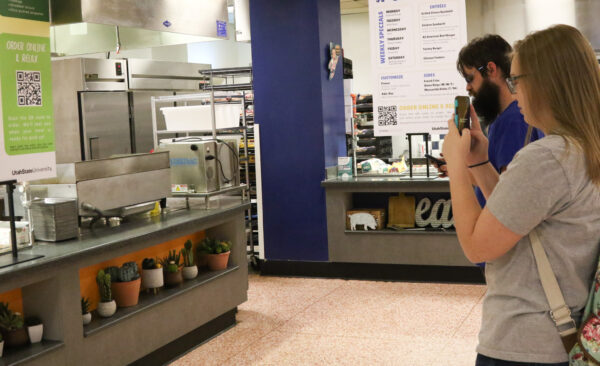To scan, or not to scan?
With each fall semester at USU, there will be changes made from the year before. The senior class moves on to their future, leaving space for the incoming students to begin their journey. Perhaps a new club appears at Day on the Quad, or maybe there’s a change in leadership.
This year, however, one change in particular has divided students and employees alike, and it has to do with one of the most important resources on campus, food.
Over the summer, Dining Services took the initiative to replace their traditional face-to-face ordering with a new system. Because of this change, anyone that comes into either the Marketplace or the Junction must now scan a QR code that leads to an ordering website.
Now, at peak mealtimes, students are met with a scene that’s quickly becoming familiar — a loose band of people cluttering around the restaurants. They scan the codes with their phones, tap at their screens to order and then put them away or scroll social media as they wander in search of somewhere to sit.
While simple, the process has had a mixed response amongst the student body. Some see no issue with the changes, but many, including sophomore Kyron Nell, are frustrated.
“It used to be super convenient,” Nell said. “You could just pop into the Marketplace or the Junction whenever. This year, I have to go in and the ordering is atrocious. I almost never go to the Marketplace anymore.”
Nell claims some of his friends have had to wait for “over an hour.”
This sudden skyrocket in wait times has caused many students to neglect their meal plans. In the past week alone, multiple posts have been made on social media stories, where students, such as @ella_bardin23 on Snapchat, offer up their orders to anyone who wants them, as delays force them to abandon their food so they can head to their next class.
More than a few students have stopped using the dining halls altogether, eating off-campus or stocking their dorms with store-bought food.
Sophomore Carlos Diaz didn’t hide the way he felt about the changes. He was open about his opinion, saying he thinks the high-volume cutoffs are unfair in a busy university setting.
“I hate the QR code system,” Diaz said. “I feel like it makes the ordering process much slower than it was last year, and the option to stop us from ordering because there’s a high volume of orders is really backwards. I think the original ordering system was faster and more convenient for the students.”
Diaz has reported he rarely eats at USU anymore, instead preferring to search for alternative locations in the valley.
“Don’t fix what’s not broken,” Diaz said.

Students Brittany Scott and Delane Hassan scan the QR code to oder food in the Marketplace, Monday, Sept. 18th. (Photo// Katie Merdes)
While students with mandatory meal plans continue to eat on-campus, lest they waste their money spent, the halls seem to feel emptier than previous years.
Despite the complaints, the adjustment looks like it has a fairly positive response among first-year students. Aidan Wimmer reported a good experience, stating, “I think the QR codes work really well. I go between 2-3 o’clock, where there’s not a ton of people there, and the wait time is just a few minutes. It’s super easy to use.”
“Some of my friends are a little on the fence about it and don’t like it too much,” Wimmer said. “But another part of my friend group thinks it’s totally fine.”
Stockton Benson, a first-year student as well as a Dining Services employee, initially shared the sentiment, stating he enjoys the new system. But when asked about the effect on his work environment, his outlook changed.
“As a student eating, it’s been great. It’s convenient,” Benson said. “I live at the LLC, so the Marketplace isn’t too far of a walk. That’s where it’s a little funny. As a student, as an eater, it’s great. But when I talk to the chefs who work at the World Market, they say that it’s a lot more of an overload.”
Benson said the update and the ensuing wait times have caused not only students stress, but his coworkers as well.
“The chefs don’t like it because it’s more work for them,” Benson said. “It’s the same amount of orders, but getting them all at once like that is just more overwhelming.”
Bridge Warth, a first-year student, also commented on the change’s effect on Dining.
“I have a friend that works at the Junction, and she says that she absolutely hates it,” Warth said. “She doesn’t like dealing with the customers that get aggravated with the system and then blame it on the workers. When the system malfunctions, it’s the employees that get the brunt of the anger.”
With students and staff complaining, many are wondering what the long-term future of the QR codes will be. Some students say no action should be taken, while others have a bevy of suggestions, ranging from mild tweaks and updating to the abolishment of the system in its entirety.
Warth was torn.
“I feel like we could return to the original face-to-face system, but I also think that we could have some kind of tweak instead of having a QR code,” Warth said. “I think it could go either way with improving, but it needs to improve.”
Where to go from here? It would likely be both difficult and costly for Dining to recall the system, and updating the website could be similarly challenging.
But the easiest option of doing nothing leaves the door open for further stress and complaints, plus the danger of long-term losses as students may choose to opt out of meal plans next semester. At this point, only one question remains, to scan, or not to scan?

